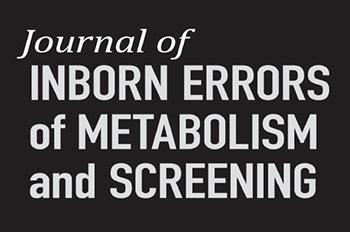Keywords:
GLB1 gene; β-galactosidase; mutation; Brazilian population; whole genome sequencing
Dear Editor,
We have previously published in this Journal the results of a molecular study on a series of patients presenting with juvenile and chronic GM1 gangliosidosis; the method was target-gene analysis using Sanger sequencing for the 16 exons and their flanking regions of the GLB1 gene [11. Baptista MB, Scherrer DZ, Bonadia LC, Steiner CE. Molecular analysis of 9 unrelated families presenting with juvenile and chronic GM1 gangliosides. J Inborn Errors Metab Screen. 2016;4:1-5. doi:10.1177/2326409816643098.
https://doi.org/10.1177/2326409816643098...
]. At that time, one of the individuals (patient 5) had only one variant identified, p.Thr500Ala, in the maternal allele. Recently, we had the opportunity to restudy this patient through Next Generation Sequencing to complete genomic analysis.
Whole Genome Sequencing (WGS) was performed using a fresh DNA sample extracted from peripheral blood in an Illumina platform after mechanical fragmentation and a PCR-free protocol. Data were processed to detect point mutations, copy number variants, and structural variants as per best practices for the bioinformatics pipeline. Quality metrics were minimum coverage over 20× and at least 90% depth above 15×. The reference genome was GRCh38/hg38. Variant nomenclature and classification followed the ACMG recommendations.
As a result, WGS was able to confirm that the patient presented compound heterozygosity for the previously identified c.1498A>G (p.Thr500Ala) variant combined with a c.1577dup (p.Trp527Leufs*5) variant. Both variants were classified as pathogenic, according to ACMG nomenclature. The former is a well-known mutation highly associated with the Morquio B phenotype [22. Bagshaw RD, Zhang S, Hinek A, et al. Novel mutations (Asn 484 Lys, Thr 500 Ala, Gly 438 Glu) in Morquio B disease. Biochim Biophys Acta. 2002;1588(3):247-253. doi:10.1016/s0925-4439(02)00172-2.
https://doi.org/10.1016/s0925-4439(02)00...
]; the second is reported in the ClinVar database with ID rs794729217 and has been previously associated with the infantile form of GM1 gangliosidosis using alternate nomenclature (1622-1627insG) [33. Silva CMD, Severini MH, Sopelsa A, et al. Six Novel b-Galactosidase Gene Mutations in Brazilian Patients With GM1-Gangliosidosis. Hum Mutat. 1999;13(5):401-409. doi:10.1002/(sici)1098-1004(1999)13:5<401::aid-humu9>3.0.co;2-n.
https://doi.org/10.1002/(sici)1098-1004(...
].
The patient’s clinical presentation corresponds to a typical Morquio phenotype, opening clinical picture in the first year of life with gait abnormalities and progressive skeletal deformity comprising short trunk dwarfism, pectus carinatum, kyphoscoliosis, hip dysplasia, anterior projection of the pelvis, genu varum, flat feet, and dysostosis multiplex in the skeletal survey; final stature is 151 cm. At the age of 17 years, he presented a left inguinal hernia that needed surgical correction. Besides abnormal gait and stable mild dysarthria and dysphagia, he developed no other progressive neurological symptoms until his last evaluation at the age of 28 years; intellectual function is normal. His clinical description has also been presented by Kannebley et al. [44. Kannebley JS, Silveira-Moriyama L, Bastos LOD, Steiner CE. Clinical Findings and Natural History in Ten Unrelated Families with Juvenile and Adult GM1 Gangliosidosis. JIMD Rep. 2015;24:115-122. doi:10.1007/8904_2015_45.
https://doi.org/10.1007/8904_2015_45...
] as patient number 6.
This complementary study was made possible through access to the data and findings generated by the Rare Genomes Project, an initiative of Hospital Israelita Albert Einstein in partnership with the Programa de Apoio ao Desenvolvimento Institucional do Sistema Único de Saúde (PROADI-SUS) from the Brazilian Ministry of Health (25000.083098/2019-71).
References
- 1. Baptista MB, Scherrer DZ, Bonadia LC, Steiner CE. Molecular analysis of 9 unrelated families presenting with juvenile and chronic GM1 gangliosides. J Inborn Errors Metab Screen 2016;4:1-5. doi:10.1177/2326409816643098.
» https://doi.org/10.1177/2326409816643098 - 2. Bagshaw RD, Zhang S, Hinek A, et al. Novel mutations (Asn 484 Lys, Thr 500 Ala, Gly 438 Glu) in Morquio B disease. Biochim Biophys Acta 2002;1588(3):247-253. doi:10.1016/s0925-4439(02)00172-2.
» https://doi.org/10.1016/s0925-4439(02)00172-2 - 3. Silva CMD, Severini MH, Sopelsa A, et al. Six Novel b-Galactosidase Gene Mutations in Brazilian Patients With GM1-Gangliosidosis. Hum Mutat 1999;13(5):401-409. doi:10.1002/(sici)1098-1004(1999)13:5<401::aid-humu9>3.0.co;2-n.
» https://doi.org/10.1002/(sici)1098-1004(1999)13:5<401::aid-humu9>3.0.co;2-n - 4. Kannebley JS, Silveira-Moriyama L, Bastos LOD, Steiner CE. Clinical Findings and Natural History in Ten Unrelated Families with Juvenile and Adult GM1 Gangliosidosis. JIMD Rep 2015;24:115-122. doi:10.1007/8904_2015_45.
» https://doi.org/10.1007/8904_2015_45
-
Ethics Approval and Consent to Participate
The study followed the Declaration of Helsinki and was approved by the Institutional Ethics Committee Board of the State University of Campinas under protocol CAAE number 29567220.4.2005.5404. Written consent of the participant was obtained before the research. -
Funding
This research received no external funding.
Publication Dates
-
Publication in this collection
23 Feb 2024 -
Date of issue
2024
History
-
Received
22 Dec 2023 -
Accepted
25 Jan 2024

